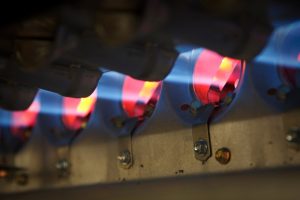Like all mechanical parts, furnaces can encounter problems, especially with components as essential as the electronic igniter. At Hall’s Heating, Air Conditioning & Refrigeration, we often find that a malfunctioning electronic igniter is a common cause of furnace trouble. In this post, we’ll explain what an electronic igniter is, how it differs from traditional pilot lights, and the signs that indicate it might be time for a replacement to keep your central heating working.
What Is an Electronic Igniter?
In older furnace models, pilot lights were used to ignite the fuel to produce heat. Today, most modern furnaces have switched to electronic ignition systems. Electronic igniters are designed to light only when the furnace is ready to heat, conserving energy and increasing efficiency. There are generally two types of electronic igniters: intermittent pilot igniters, which use a small electric spark to light a pilot flame that, in turn, ignites the furnace, and hot surface igniters, which use an electric current to heat up a silicon carbide or silicon nitride element that ignites the gas burner.
While electronic igniters have improved efficiency and reliability, they can still fail over time. When an igniter starts to fail, it often shows certain warning signs. Recognizing these early on can save you from being left without heat when you need it most.
Common Signs Your Furnace Igniter Needs Replacement
Furnace Won’t Start
If you notice that your furnace isn’t kicking on when it should, the igniter could be at fault. When you set your thermostat to a higher temperature, the furnace should begin its heating cycle. If nothing happens, your electronic igniter may have failed, preventing the furnace from igniting the gas burner. Other furnace problems can cause this issue too, so have a professional check the system to determine the exact cause.
Short-Cycling
Short-cycling occurs when the furnace turns on for only a brief period and then shuts off before completing a full heating cycle. This behavior could point to an issue with the electronic igniter. If the igniter doesn’t work properly, the furnace may turn off as a safety measure, leading to frequent and incomplete cycles.
Clicking Sounds
Clicking sounds from the furnace when it tries to start can be a sign that the igniter is struggling. A properly functioning igniter should only make minimal noise when it lights the burners. If you hear a constant clicking noise, it’s likely that the igniter is malfunctioning or failing to ignite the fuel.
Yellow or Weak Flame
If your furnace has an intermittent pilot igniter and you notice a weak or yellow flame, the igniter may be unable to produce a strong enough spark. A healthy pilot flame should be strong and blue, indicating efficient combustion. A weak or yellow flame could mean that the igniter isn’t providing enough heat or spark to sustain a proper flame. If you notice a weak or discolored flame, contact a technician right away to ensure your home stays safe.
Furnace Error Codes
Many modern furnaces are equipped with diagnostic systems that display error codes when there’s a problem. If you see an error code indicating ignition failure or a similar issue, it’s likely due to a malfunctioning igniter. Error codes vary by furnace model, so you may need to consult your furnace’s manual or reach out to a technician to interpret the code.
If you think you need heater service in Bossier City, LA for your furnace, reach out to our experts right away.
Hall’s Heating, Air Conditioning & Refrigeration. Call the doctor of home comfort today.



